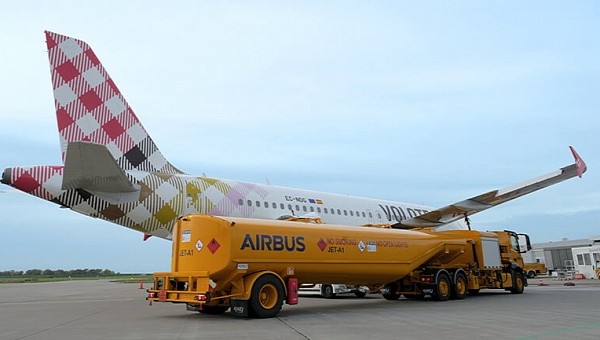Airbus is not only linked to several pioneering flights powered by sustainable aviation fuel (SAF) but also continues to increase the use of this alternative fuel for more and more of its regular operations and facilities.
Numbers show that SAF can cut a significant amount of CO2 emissions (an average of 80%) throughout its lifecycle. At the moment, the SAF that is produced in bio-refineries is blended with kerosene in certain proportions, becoming what is known as “drop-in” fuel. This fuel is certified to be used for commercial aircraft, just like the conventional Jet A1, without any modifications to the aircraft’s systems.
Airbus aims to reduce its own Scope 1 and 2 emissions by 63% compared to 2015, with 2030 as a deadline. To do so, it’s using SAF in several ways.
One of them is using green jet fuel for operations and logistics at its facilities in different parts of the world. The latest to gradually replace conventional fuel with SAF are the ones in Toulouse, France, and Tianjin, China. This comes after an Airbus A320neo completed the first flight powered by Chinese SAF last month.
Alternative fuel is also used to power the fleet of Beluga aircraft that carry large aircraft components from one facility to another. ATI (Airbus Transport International) has been doing this since 2019 but plans to extend the routes on which it is used. Plus, all the Airbus manufacturing sites that benefit from the ATI logistics services could be supplied with SAF by the end of the decade.
SAF is also being introduced for employee shuttle services. Volotea has been operating Monday-to-Friday shuttles for Airbus since 2019, but, starting this Fall, the airline will do so using SAF. More specifically, a 34% SAF blend will power the regional jet flying from the Hamburg-Finkenwerder Airport to the Toulouse-Blagnac Airport.
However, in order to expand the use of green jet fuel, even more, production must also increase. Developing the SAF market is an important goal in itself for all players in the aerospace industry.
Airbus aims to reduce its own Scope 1 and 2 emissions by 63% compared to 2015, with 2030 as a deadline. To do so, it’s using SAF in several ways.
One of them is using green jet fuel for operations and logistics at its facilities in different parts of the world. The latest to gradually replace conventional fuel with SAF are the ones in Toulouse, France, and Tianjin, China. This comes after an Airbus A320neo completed the first flight powered by Chinese SAF last month.
Alternative fuel is also used to power the fleet of Beluga aircraft that carry large aircraft components from one facility to another. ATI (Airbus Transport International) has been doing this since 2019 but plans to extend the routes on which it is used. Plus, all the Airbus manufacturing sites that benefit from the ATI logistics services could be supplied with SAF by the end of the decade.
SAF is also being introduced for employee shuttle services. Volotea has been operating Monday-to-Friday shuttles for Airbus since 2019, but, starting this Fall, the airline will do so using SAF. More specifically, a 34% SAF blend will power the regional jet flying from the Hamburg-Finkenwerder Airport to the Toulouse-Blagnac Airport.
However, in order to expand the use of green jet fuel, even more, production must also increase. Developing the SAF market is an important goal in itself for all players in the aerospace industry.







